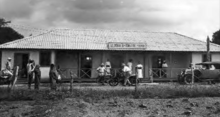
The Horn of Africa (HoA), also known as the Somali Peninsula, is a large peninsula and geopolitical region in East Africa. Located on the easternmost part of the African mainland, it is the fourth largest peninsula in the world. It is composed of Somalia, Djibouti, Ethiopia, and Eritrea. Although not common, broader definitions include parts or all of Kenya and Sudan. It has been described as a region of geopolitical and strategic importance, since it is situated along the southern boundary of the Red Sea; extending hundreds of kilometres into the Gulf of Aden, Guardafui Channel, and Indian Ocean, it also shares a maritime border with the Arabian Peninsula.

Italian Somaliland was a protectorate and later colony of the Kingdom of Italy in present-day Somalia, which was ruled in the 19th century by the Sultanate of Hobyo and Majeerteen in the north, and in the south by the political entities; Hiraab Imamate and the Geledi Sultanate.

The Majeerteen, alternately known as MohammedHarti, are a Somali sub-clan part of the Harti branch of the Darod clan. Traditionally, they inhabit extensive territories in the Bari, Nugaal, and Mudug regions of Somalia, spanning from Bosaso to Garacad, mainly in Puntland state. Additionally, Majeerteen populations are present in southern towns such as Kismayo.

Mohamoud Ali ShireMBE was a Somali Sultan of the Warsengali Sultanate. He bore the title Sultan of the Warsangali. He was centered at Las Khorey.
Hobyo, is an ancient port city in Galmudug state in the north-central Mudug region of Somalia.
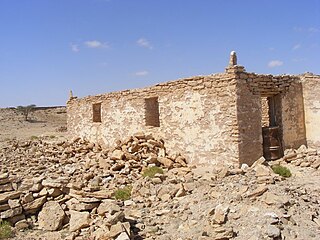
The Harti, (Somali: Harti), are a Somali clan that trace their lineage back to SalehAbdi (Harti). They are a sub-clan of the larger Darod clan. Notable sub-clans within Harti include the Majeerteen, Dhulbahante, Deshiishe and the Warsengeli. They predominantly reside in the apex of the Horn of Africa and its surrounding regions. Furthermore, in the southern territories, the clan's settlements span both sides of the Kenya-Somalia border.

The Sultanate of Hobyo, also known as the Sultanate of Obbia, was a 19th-century Somali Sultanate in present-day northeastern and central Somalia and eastern Ethiopia. It was established in 1878 by Yusuf Ali Kenadid.

Dubat ; Arabic:العمائم البيضاء ); ḍubbāṭ: English: White turban) was the designation given to members of the semi-regular armed bands employed by the Italian "Royal Corps of Colonial Troops" in Italian Somaliland from 1924 to 1941. The word dubat was derived from a Somali phrase meaning "white turban".

The Somaliland campaign, also called the Anglo-Somali War or the Dervish rebellion, was a series of military expeditions that took place between 1900 and 1920 in modern-day Somaliland. The British were assisted in their offensives by the Ethiopian Empire and the Kingdom of Italy.
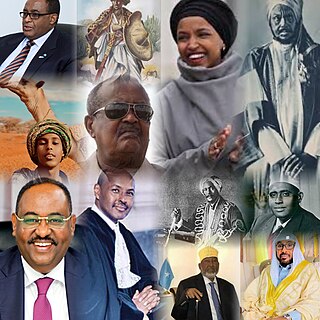
The Osman Mahmoud, are a Somali sub-clan part of the Majeerteen Harti branch of the larger Darod clan. The sub-clan has a rich tradition and history which include the sultanates of Majeerteen and Hobyo.

Yusuf Ali Kenadid was a Somali Sultan and the founder of the Sultanate of Hobyo. He was succeeded to the throne by his son Ali Yusuf Kenadid.

The Majeerteen Sultanate, or Majerteen Kingdom also known as Majeerteenia and/or Migiurtinia, was a Somali kingdom centered in the Horn of Africa. Ruled by Boqor Osman Mahamuud during its golden age, the sultanate controlled the areas which are now called Puntland. The earliest mention of the kingdom is the 16th century. The polity had all of the organs of an integrated modern state and maintained a robust trading network. It also entered into treaties with foreign powers and exerted strong centralized authority on the domestic front.

Osman Mahamuud, also known as Uthman III ibn Mahmud, was a Somali king. He led the Majeerteen Sultanate during the 19th century.

The military history of Somalia encompasses the major conventional wars, conflicts and skirmishes involving the historic empires, kingdoms and sultanates in the territory of present-day Somalia, through to modern times. It also covers the martial traditions, military architecture and hardware employed by Somali armies and their opponents.

This is a list of Somali aristocratic and court titles that were historically used by the Somali people's various sultanates, kingdoms and empires. Also included are the honorifics reserved for Islamic notables as well as traditional leaders and officials within Somali customary law (xeer), in addition to the nobiliary particles set aside for distinguished individuals.
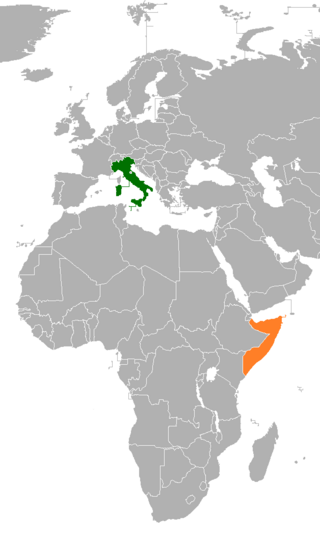
Italy–Somalia relations are bilateral relations between Italy and Somalia.

Ali Yusuf Kenadid was a Somali Sultan and the second ruler of the Sultanate of Hobyo.

The Royal Corps of Somali Colonial Troops was the colonial body of the Royal Italian Army based in Italian Somaliland, in present-day northeastern, central and southern Somalia.

The Hiraab Imamate, also known as the Yacquubi Dynasty, was a Somali kingdom that ruled parts of the Horn of Africa during the 16th century till the 19th century until it was incorporated into Italian Somaliland. The Imamate was governed by the Hiraab Yacquub Dynasty. It was founded by Imam Omar who successfully rebelled against and defeated the Ajuran Sultanate, later establishing an independent kingdom.
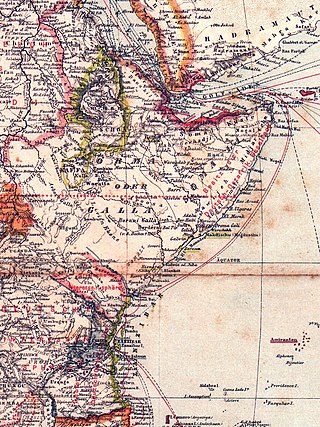
German colonial efforts on the Somali coast were pursued from 1885 to 1890. Representatives of the German East Africa Company signed friendship and protection treaties with local rulers in the coastal cities of Somalia in 1885 and 1886 with the aim of acquiring areas north of Wituland. In 1888 and 1890, respectively, the project, which overlapped with British and Italian claims, was abandoned.



